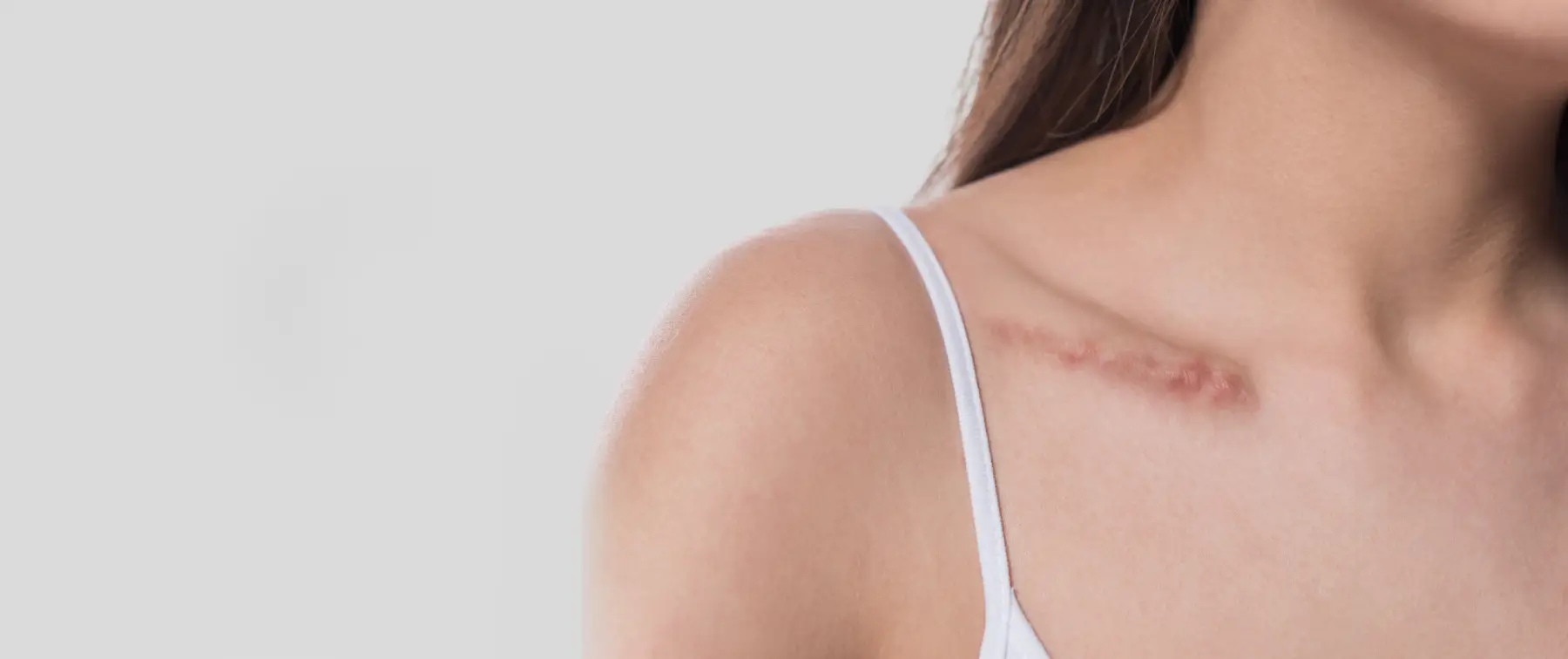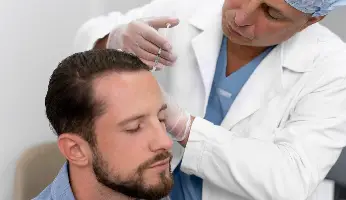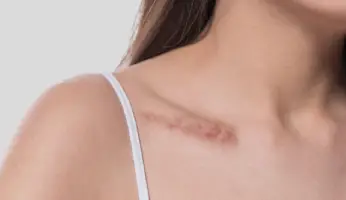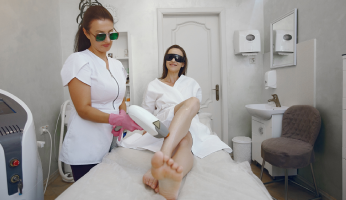
Struggling with noticeable, abnormally healed skin wounds- aesthetically unappealing scars? Skin experts at Charma Clinic understand your consciousness about your looks, especially when you have large, raised scars on visible areas of your body like your face or hand. Our top-notch skin professionals offer affordable and effective scar removal options for all kinds of scars and even help prevent surgical wounds from developing into raised scars. One of our areas of expertise is Keloid Treatment in Bangalore.
What are keloid scars?
Keloid scars are one of the forms of raised scars that appear when an injured or wounded skin heals. They are the result of the unusual natural healing response of the body that encourages excess collagen growth on the site of the original injury.
During the wounded skin repair, collagen growth extends the boundaries of the wounded skin, resulting in a raised, red lumpy scar that is larger than the original injury.
As per Best Doctor for Keloid Removal in Bangalore at Charma Clinic, ‘Keloid scar can develop from a wound created by accident, surgery, a burn, a cut, an insect bite, chicken pox, skin piercing, a tattoo, or a severe acne breakout’. It presents itself after about 3 months or more after skin injury and may continue to grow for years to come. Any area of the body can be affected by a keloid scar. However, mostly it is seen on the neck, back, ears, chest, and shoulders.
Who is more susceptible to keloid scar formation?
Overall susceptibility to producing keloid scars may run in families, implying that genetics may play a role in their formation. Furthermore, if an individual has already had a keloid scar, they may be at risk of acquiring another one. Other risk factors include being younger than 30 years, being pregnant, being an adolescent, and/or being Black, Asian, or Latino.
Symptoms of keloid scars:
The following are the most prevalent keloid symptoms:
- A raised scar tissue that looks like a hump at the site of a healed skin injury
- Pigmentation of the skin- pink, red, purple, or darker skin with borders being darker than the centre
- Irritation
- Painful to touch
- Itchy
- Redness
- Tenderness
- Soft and doughy or hard and rubbery scar tissues.
How is a diagnosis of keloid scars done by expert dermatologists?
The best doctor for keloid removal in Bangalore diagnoses keloid scars by just looking at the affected area.
- However, other skin conditions, such as swelling as an allergic reaction to wearing a gold earring may resemble a keloid.
- In some cases, the dermatologist may recommend a skin biopsy if he or she suspects some other conditions. It will help diagnose the other possibilities and ensure the diagnosis of keloid.
Keloid scar treatments in Bangalore
Keloids rarely cause a major risk to a person’s health. However, it can cause pain and irritation at times. Furthermore, they do not have an appealing appearance. As a result, the majority of people want keloid scar removal as soon as possible.
Fortunately, there are several options for Keloid treatment in Bangalore. Some of them are invasive, while others are completely non-invasive. The goal of any keloid scar removal option is to soften, flatten, or shrink the keloid scars. In general, keloid removal is challenging and keloid scars may recur. Combination treatments are advised to obtain optimal results.
1. Medications:
Corticosteroids are a common medicine used to treat keloids as these carry a very low risk of skin irritation. Other medications that could help treat keloid scars include:
- Antineoplastic agents
- Immunosuppressants
- Immunomodulators
- Retinoids
- Calcium channel blockers
- Some topical products.
2. Pressure earring, dressing, or garment:
It is frequently used to reduce blood flow during keloid surgery. This may prevent a keloid from recurring. It can be difficult and uncomfortable to use a pressure earring or garment as suggested. To see improvements, patients must wear it for 12 to 20 hours every day for several months. A pressure earring is typically the most convenient to wear.
3. Silicone gel sheets:
Over time, silicone gel sheets can serve as a flattening agent for the keloid scar, allowing an individual to get rid of it.
4. Cryotherapy:
Freezing liquid nitrogen is used to shrink small keloids and reduce their strength by disrupting their structural integrity. In the therapy, the scar tissues are frozen resulting in localised vascular injury and cut off in the supply of blood to the scar. The resulting scar tissue necrosis helps to minimise keloid scar appearance and related discomfort. Although this treatment for keloids is effective, it may induce skin discoloration. The treatment usually requires only one session and is completely painless.
5. Laser treatment:
Laser treatment is considered the most effective treatment for keloids. Pulsed-dye lasers can effectively heal keloid scars, even larger ones. This treatment not only improves the appearance of the scar but also alleviates the irritation and discomfort caused by the lesion. Typically, multiple laser sessions in a gap of four to eight weeks are performed to completely reduce the appearance of keloid scars. There are no serious side effects from this treatment; however, bruising can occur.
6. Surgery:
Although most people do not want to have a surgical procedure to remove a keloid, it is necessary in the case of old, large keloids. During surgery, a large lump on the skin is excised. While this procedure appears to be a permanent solution, there is an increased chance that keloids will recur. As a result, the doctor may recommend additional treatment following surgery to reduce the risk of recurrence. For example, surgery can be paired with postoperative low-dose radiotherapy (LDRT) within the first 6 to 24 hours after surgery to prevent early wound healing cascades.
7. Ligature:
If a surgical thread can be tied around the keloid, it will gradually cut into the keloid, which may cause it to break off. For the keloid scar to fall off, every two to three weeks, patients will need to tie a new surgical thread around the keloid.
8. Cryosurgery:
Keloids can be effectively treated with cryosurgery, especially if they are small or have just appeared. It involves applying freezing temperatures to a lesion, usually with liquid nitrogen. It is commonly used to remove small keloids and acne scars.
Can keloid scars be avoided?
Preventing keloid growth is challenging, but not impossible.
While it is hard to avoid all skin injuries, taking precautions can help reduce the chance of developing keloids. This might involve carefully considering the potential risks of body piercings, tattoos, and elective procedures, especially if an individual has a history of keloids.
Remember that keloids can develop from minor injuries such as scratches and ingrown hairs if the skin is prone to producing these scars.
Some preventive measures include:
- If an individual has been injured or had surgery, follow the doctor's instructions for proper wound care
- If an individual has piercings, apply petroleum gel or silicone gel sheets to the pierced area.
FAQs on Keloid Scar Treatment
Can you permanently remove a keloid?
Keloids cannot be removed permanently, however, there are procedures to improve their appearance while reducing complications. These types of treatment include topical solutions, clinical treatments, and, in some cases, home remedies; however, professional medical guidance should be followed.
Do dermatologists remove keloids?
Yes, dermatologists have the expertise to remove keloids. Other specialists, including laser specialists, may be able to remove keloid scars as well. However, dermatologists usually provide the best keloid treatment.
What is the most effective treatment for keloids?
Dr. Rajdeep Mysore, dermatologist and keloid doctor in Bangalore will recommend the best keloid treatment for the patient’s specific skin condition and situation. The most suitable option differs from person to person and may include cryosurgery, laser therapy, or other procedures. It is important to visit a dermatologist to establish the best treatment for a patient's particular keloid and skin condition.
What is Keloid scar removal cost?
The Keloid scar removal cost may vary from patient to patient and is determined by factors such as:
- The treatment chosen
- The expertise of the dermatologist
- The location of the clinic
- The severity of the problem.
- As a result, it is recommended that patients speak with an expert skin doctor to determine the exact cost of their specific treatment.
If one is dealing with any type of ugly or painful keloid scar one can get it managed with the best dermatological keloid scar removal treatment in Bangalore with Dr. Rajdeep Mysore at Charma Clinic.




